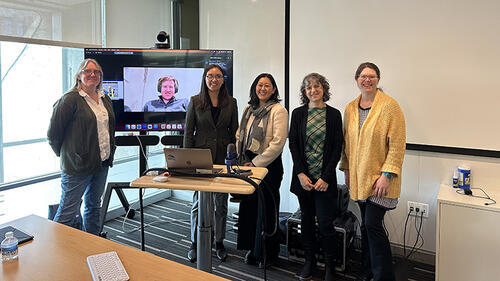
On March 28, Sophia Hollick successfully defended the thesis “COSINE-100 and ANAIS-112: Two Experiments, One Search for the Annual Modulation of Dark Matter” (advisor: Reina Maruyama).
Hollick explained, “Overwhelming evidence has been observed for the existence of dark matter; however, it has yet to be directly detected. Since 1997, the DAMA/LIBRA experiment has claimed to detect a dark matter signal, taking the form of an annual modulation consistent for over 20 yearly cycles. However, experiments utilizing different detector technologies have excluded their result by several orders of magnitude. To definitively test the validity of the claim, COSINE-100 and ANAIS-112 have mounted experiments with the same detector medium, NaI(Tl). COSINE-100 was located at Y2L underground laboratory in South Korea and took data from October 2016 until March 2023 and ANAIS-112 is housed at LSC in Canfranc, Spain, taking data from August 2017 through the present day. Both experiments have reported results consistent with no modulation and are on the cusp of concluding the DAMA/LIBRA debate.”
Hollick continued, “Together, their combined search for dark matter excludes the DAMA signal, resulting in an impactful contribution to our understanding of dark matter. Also presented are the investigation of modulation arising from analysis artifacts in the dark matter search and the efforts to optimize radiopurity in next generation NaI(Tl) detectors by measuring their cosmogenic activation rates with artificially activated NaI(Tl) crystals.”
Hollick will continue working at the University of Zaragoza as a postdoctoral researcher to resume work with ANAIS-112 and additionally work with IAXO, an axion helioscope experiment.
Thesis Abstract: Overwhelming evidence has been observed for the existence of dark matter; however, it has yet to be directly detected. Since 1997, the DAMA/LIBRA experiment has claimed to detect a dark matter signal, taking the form of an annual modulation consistent for over 20 yearly cycles. Though DAMA/LIBRA reports a 13.7s significance, experiments utilizing different detector technologies have excluded their result by several orders of magnitude. To definitively test the validity of the claim, COSINE-100 and ANAIS-112 have mounted experiments with the same detector medium, NaI(Tl). Both experiments have reported results consistent with no modulation and are on the cusp of concluding the DAMA/LIBRA debate.
The results of the search for the annual modulation of dark matter by direct combination of the COSINE-100 and ANAIS-112 experiments and the validation of the consistency of results between them are presented in this thesis. Combining experimental data achieves an exposure of 485 kgyr for the 3-year combined datasets and 984 kgyr for the 6-year combined datasets, resulting in values compatible with no modulation with respective significances of 4.1s and 5.3s for the exclusion of the DAMA/LIBRA claim. Also presented are the investigation of modulation arising from analysis artifacts in the dark matter search and the efforts to optimize radiopurity in next generation NaI(Tl) detectors by measuring their cosmogenic activation rates with artificially activated NaI(Tl) crystals.
Defense Committee: Reina Maruyama (advisor), Maria Luisa Sarsa, Laura Newburgh, Helen Caines, and Ian Moult